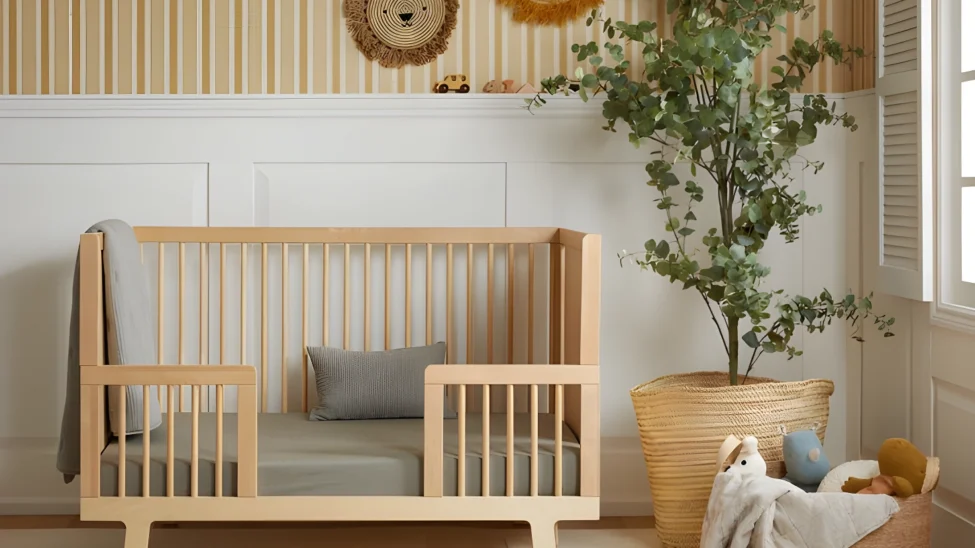
Why Materials Deserve More Attention Than You’d Think
I remember standing in the middle of a baby store, surrounded by cribs that all looked kind of the same. But the more I read the labels, the more I realized how different they were — not in design, but in what they were actually made of. And let’s be honest, when it comes to where your baby is going to spend hours sleeping, breathing, and maybe even chewing on the rails — materials matter.
It’s easy to get drawn in by aesthetic: the warm oak finish, the stylish minimalism. But under that shiny surface might be pressed wood full of formaldehyde or paint with questionable origins. Choosing a safe crib isn’t about paranoia — it’s about understanding what your baby will be in close contact with, day and night.
Your baby’s crib isn’t just furniture — it’s a micro-environment. And every detail, from wood to varnish, becomes part of your baby’s world.
The Usual Suspects: Wood, MDF, and Everything in Between
Let’s start with the classic: solid wood. When untreated or finished with safe, water-based coatings, it’s generally the best option. Maple, birch, and beech are popular for a reason — they’re durable and don’t splinter easily. But not every crib labeled as “wood” is 100% solid. Many are actually made from MDF (medium-density fiberboard) or particle board — which can release VOCs (volatile organic compounds), especially when combined with glues and adhesives.
What about painted finishes? This is where it gets tricky. Even today, some imported cribs use paints and varnishes that don’t meet safety standards in the U.S. or Europe. Always look for clear labeling: “non-toxic,” “water-based,” and ideally, certifications like GREENGUARD Gold. And even then, sniff. Yes, really. If a new crib has a strong chemical smell that doesn’t fade, something’s off.
Then there are hybrid models: cribs that combine metal and wood, or plastic components like teething rails. In theory, these can be fine — but again, look for certifications and avoid anything with BPA, phthalates, or PVC.
Just because it’s sold in a baby store doesn’t mean it’s automatically safe. Labels, certifications, and even your nose are your best tools.
The “Natural” Trap: What Marketing Doesn’t Always Tell You
There’s a growing trend — thankfully — toward organic, eco-friendly baby products. But the word “natural” gets thrown around like confetti. I’ve seen cribs labeled as “organic wood” (what does that even mean?), or “green,” with no backup whatsoever.
Some brands do the work: they get certified, disclose materials, and are transparent about finishes. Others, unfortunately, just jump on the trend and slap vague eco-claims on packaging. Don’t fall for it. Ask questions. Real “safe” means transparency, not buzzwords.
When we were setting up my son’s room, I reached out to a brand about their “natural water-based finish.” They responded with a PDF of lab results, listing every compound. That gave me peace of mind. Compare that to another brand that ghosted me when I asked about their MDF percentage.
Natural doesn’t always mean safe. And safe doesn’t always shout from the label — sometimes you have to dig.
The Crib We Chose for Ivan (And Why)
After weeks of research (and a few sleepless nights of my own), we ended up choosing a solid beech wood crib, made in Denmark, with a simple water-based finish. It wasn’t the cheapest, and it wasn’t the most stylish, but it ticked the boxes that mattered to us. No MDF. No chemical smell. Clear compliance with European safety standards.
Did I overthink it? Maybe. But when I watched Ivan napping in that crib, knowing he wasn’t inhaling mystery fumes or gnawing on synthetic coatings — it was worth every email I sent to those customer service reps.
And I’ll tell you this: the crib still looks great after three years. It’s since moved on to my friend’s baby girl. It’s solid. Safe. And it doesn’t squeak.
Sometimes peace of mind isn’t in the design — it’s in what you can’t see but know is there.
After the Purchase: What Else Matters
Even after you choose a safe crib, there are a few more things to stay mindful of. First — the mattress. It should fit snugly (no more than two fingers of space around it) and be made of safe, breathable materials. Again, certifications help. And skip the extra padding, bumpers, and “breathable” mesh liners unless they’re medically necessary — most are more decorative than helpful.
A crib is never just a crib. It’s where your baby dreams, rests, grows — and that makes it worth every thoughtful step.
Second — keep an eye on wear and tear. Even the safest paint can chip, especially during teething. If that happens, touch up with approved finishes or, if in doubt, sand gently and leave it untreated. And finally, air the room well. Cribs — even safe ones — release small amounts of compounds when new. A few days of good airflow before baby moves in makes a difference.
This process may seem a bit much at first glance, but once you go through it once, it becomes part of your rhythm. And that rhythm — of intentional choices and little routines — is at the heart of calm parenting.


